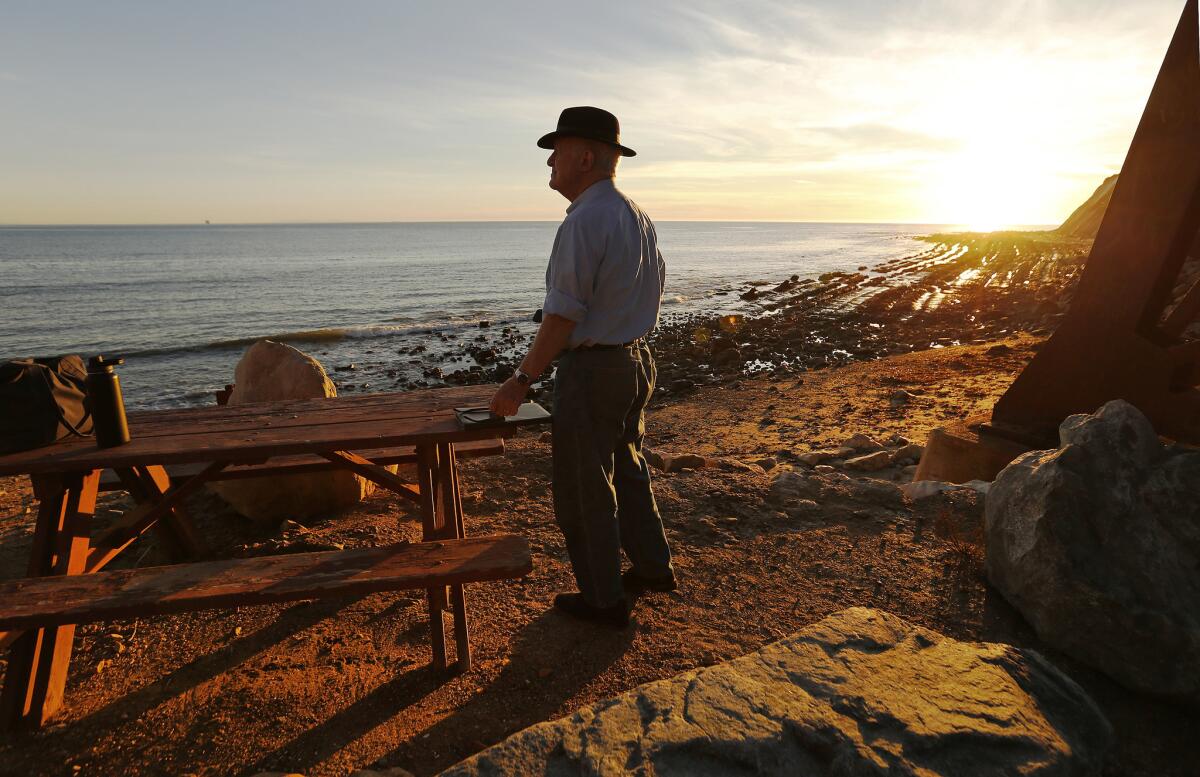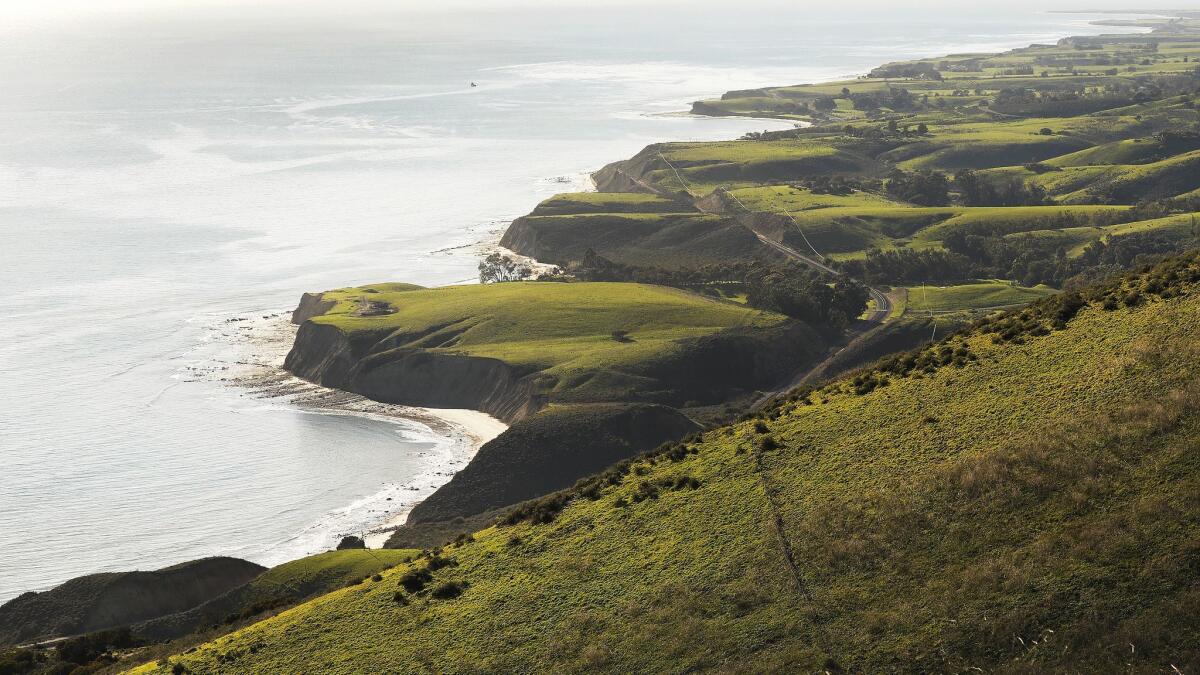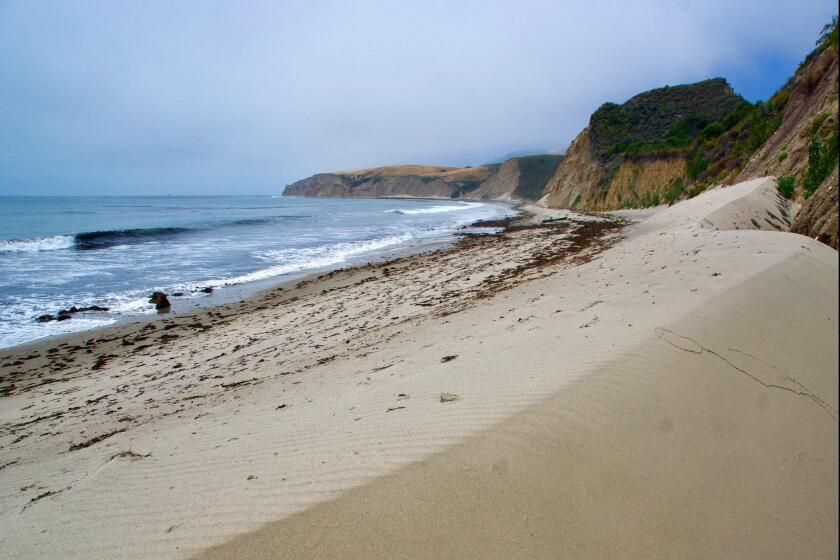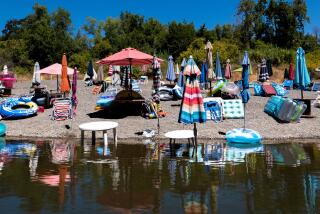Newsom signs bill to open Hollister Ranch beaches to the public

- Share via
Gov. Gavin Newsom has signed into law a bill designed to open the exclusive beaches at Hollister Ranch — a significant move forward under his administration on an issue that has stalled for decades in the face of powerful landowners.
The law declares that the public must be allowed to enter the ranch by land and access some of its 8.5 miles of shoreline by April 2022. Further access would be phased in under a comprehensive plan to be developed in the next two years.
It is also now a crime, punishable by tens of thousands of dollars in fines, for any action by a person or group “to impede, delay, or otherwise obstruct the implementation of” public access to these coveted beaches and surf breaks in Santa Barbara County.
Assemblywoman Monique Limón (D-Santa Barbara), who wrote the bill, said the legislation comes after almost 40 years of efforts to open this stretch of coastline to the public.
“No matter your ZIP Code, all Californians deserve a chance to enjoy our public parks and beaches,” she said. “Hollister Ranch is no exception.”
Until Newsom signed the bill on Wednesday, it was not clear where he stood on it.
The legislation, Assembly Bill 1680, is tougher than a similar measure vetoed last year by then-Gov. Jerry Brown. This year’s bill sailed out of the Legislature, followed by declarations of support from the lieutenant governor, the state’s attorney general and controller, as well as a number of state agencies and environmental groups.
Ranch owners and their lobbyists also made their case in recent weeks to the governor and in editorials, calling the legislation unnecessary and hinting at more opposition and lawsuits.
In a statement to The Times, Newsom made clear his position on beach access for all.
“As Californians, respect and reverence for our beaches is in our DNA, so much so that we enshrined public beach access into our state Constitution,” he said. “I’ve long fought to protect these public treasures for future generations and to ensure any person can experience their beauty. That won’t change now that I’m governor.”
Opening the beaches to the public now lies in the details. Ranch owners have long contended that this pristine stretch of coast has benefited from their private stewardship. Many worry what unfettered access, unmanaged trash and extra foot traffic could do to their years of work protecting the land.
Sam Schuchat, executive director of the California State Coastal Conservancy, said that the agencies designing and implementing the access plan will do it in a way that “responsibly and safely introduces public access to this special part of the coast.”

In an agreement signed this year, the conservancy, the California Coastal Commission, the State Lands Commission and California State Parks pledged to work efficiently to expand and enhance “meaningful, safe, environmentally sustainable and operationally feasible public access to and along the coast at the ranch.”
Efforts are already underway and have so far been collaborative — even with the ranch, officials said.
In July, about 20 officials from all four agencies, as well as Santa Barbara County, met with the Hollister Ranch Owners Assn. and toured the shoreline — yet another milestone in a standoff that in past decades had blocked state agencies from even entering the ranch.
Surveyors from the State Lands Commission have also been allowed in to map the public beaches for the first time.
The legislation specifies that the ranch must continue to grant access to state officials as they work on the public access plan.
Monte Ward, president of the Hollister Ranch Owners Assn., which represents the more than 1,000 people who own a share of the ranch today, said the new legislation risks more conflict and litigation. He said the ranch has been cooperating with state officials on recent initiatives but this bill might derail these good-faith efforts.
“We believe the courts will conclude that AB 1680 is unconstitutional,” Ward said. “As a practical matter, we believe the legislation will prove to be an impediment to the current collaborative efforts and the state’s desire to enhance public access to the beaches at Hollister Ranch.”
Jack Ainsworth, executive director of the coastal commission, said that “for our part, we will continue with this collaborative process that’s already begun and we hope all stakeholders will do likewise.”
“But if not,” he said, “this bill provides some important guardrails.”
Development fees, which were subject to public scrutiny and controversy last year, have also been raised to $33,000 from $5,000 for ranch owners under the new law. This money will go into a fund dedicated to providing public access at the ranch.
Marce Gutiérrez-Graudiņš of Azul, who works on bringing more Latino voices to coastal issues, said that the governor’s signature resonates with many communities.
“This is a really huge deal, the folks that we work with already don’t feel comfortable going to the beach, they feel like they don’t belong,” she said Thursday. “This conveys to the public that all of California’s beaches, even at Hollister, are truly open to all.”
Public pressure to open the beaches mounted last year after ranch and coastal officials agreed, following years of litigation, to a controversial deal that would have allowed access only to ranch owners, their guests, visitors with guides and those who could boat or paddle in from two miles away.
The Times published the terms of this deal, which was struck behind closed doors. Coastal officials heeded the public outcry and have looked for new ways to obtain access once and for all.
A coalition of nonprofits has since been trying to stop the controversial settlement in court. In a ruling this year, a Santa Barbara County Superior Court judge refused to approve the settlement and gave the coalition a chance to legally challenge the deal. Ranch lawyers responded by trying to disqualify the judge, questioning her impartiality and actions that they say have made her both “judge and advocate.”
“There’s been such a long history at Hollister, they’ve resisted access every step of the way,” said Susan Jordan of the California Coastal Protection Network, which is part of the coalition challenging Hollister in court.
“I personally think it’s time for everyone to roll up their sleeves and work together to develop a plan that protects resources, respects the privacy of the residents and provides the public with the access they’ve been entitled to for the last 40 years.”
More to Read
Sign up for Essential California
The most important California stories and recommendations in your inbox every morning.
You may occasionally receive promotional content from the Los Angeles Times.












